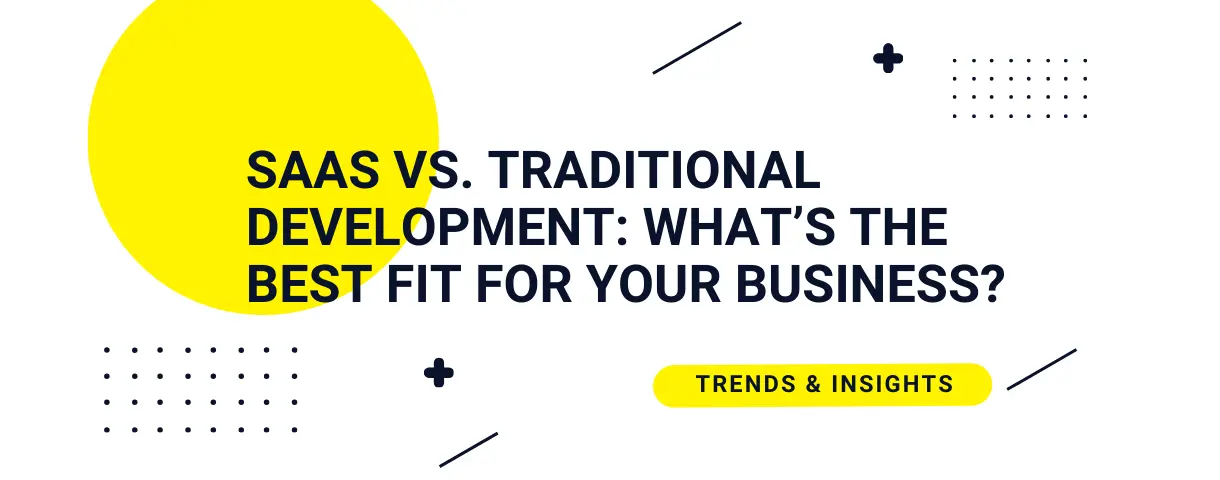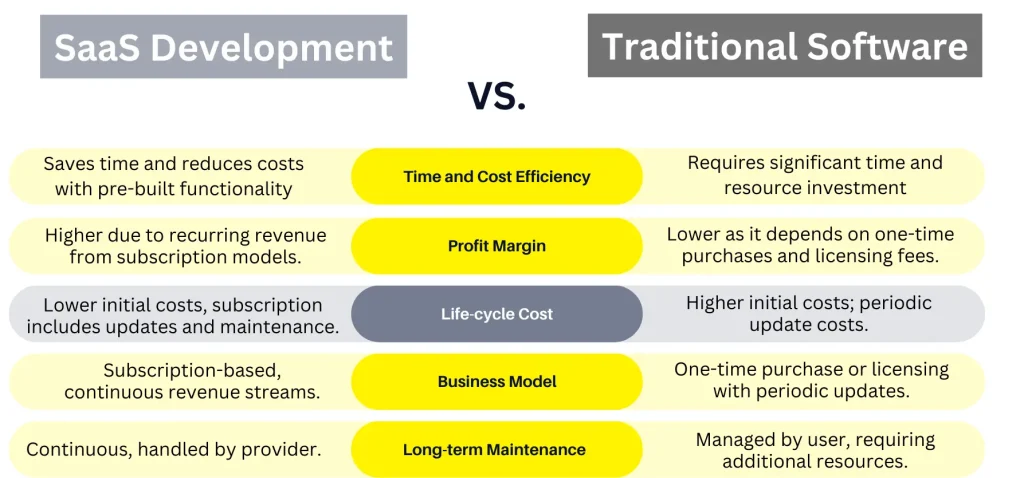- Product development
- 22 Aug 2024
SaaS development vs. traditional software development: Key Differences
The main characteristics of SaaS development are that it’s on-demand and subscription-based.



Table of contents
Contributors

A brief understanding about SaaS Development
SaaS product development delivers cloud-based solutions, enabling users to access data from any device with an internet connection. It offers flexible, customizable features tailored to the specific needs of user groups.
This version places the keyword in the first position and keeps the message concise and relevant.
SaaS development meaning
The main characteristics of SaaS development are that it’s on-demand and subscription-based, so your clients won’t need to upgrade their hardware or install it locally on their devices. Clients often use SaaS solutions from connected devices through various APIs or an Internet browser, while the software vendor handles all maintenance, making them accessible to anyone with an internet connection.
The thing about a SaaS application is that it gives you the opportunity to transform your idea into a marketable product, as we have done with DTangle, which requires a much smaller budget than building a customised application from scratch.
Basically, the primary factors driving the SaaS platform’s popularity are its affordability and flexibility. Statista anticipates that the SaaS market will grow at an annual rate of 14.4% from 2023 to 2028, reaching $282.2 billion in 2024 and $374.5 billion by 2028.
Because of this, developing SaaS applications for your clients and company can be a long-term, future-proof strategy to gain a competitive edge.
SaaS development process
The SaaS development process is also referred to as the SDLC (Software Development Lifecycle), and this structure represents the stages through which a SaaS application is built – from the original idea and concept to the deployment of the app. These can include: research, planning, designing, developing, testing, and deploying the app, with the last being continuous maintenance and updates to improve the product.
But here at BEECODED, we like to keep it simpler and easier to understand. So our version of SDLC is the following:
To capture the essence of the project, we begin by outlining the users, the business sector, and the app requirements. We outline the project’s objectives, schedule, and vision, and communicate with you at each milestone to ensure our concepts and ideas stay aligned.
Next, we start crafting a Sprint Plan, collaborating with you. First, we look over the product backlog and decide what the next sprint’s objectives should be. This establishes a system for our daily scrum meetings and focused development efforts. Every sprint concludes with an in-depth review done together with you to help us decide how best to move forward with testing and deploying upgrades.
We take the release stage very seriously, since it is clearly an important part of software development. We carefully test the software to ensure that it meets security requirements and is fast, accessible, and free of version control bugs. Our dedicated teams (maintenance, security, and DevOps) assist you during the application release phase by ensuring that everything is operating as it should.
Though this may be the conclusive stage, we prefer to think of it as an ongoing process that persists throughout our partnership. The refining phase handles all continuous iterations and changes to products, ensuring they reach their full potential during use.Basically, you have an idea for an upgrade based on the data gathered from users? Let’s see how we can put that into practice.
A brief understanding of traditional software
How has software changed over time?
Traditional software involves installing the application straight onto the user’s hardware. You can install this on servers for network-wide access, on individual PCs and laptops, or on your mobile phone or tablet. Traditional software usually comes with a one-time license fee; however, you may have extra charges for support or maintenance.
There are more types of traditional software development, depending on the hardware you’re installing the application on, or the medium in which your information is stored. The type of traditional software development varies depending on the hardware you install the application on or the medium where you store your information, development, and on-premises development.
Mobile app development
Developing a mobile app means creating software that runs on your smartphone or tablet. These apps usually need a network connection to interact with remote servers or resources.
The process starts with building installable software packages, which include all the code, binaries, and assets. Next, you need to set up backend services, like APIs, to handle data access and other functions. Finally, we test the app on the devices it’s designed for to ensure everything works smoothly.
We followed this process when building MiM – Money in Motion, a user-friendly budget-tracking app for financial education.
Web app development
While all SaaS platforms are web-based software, not all web apps qualify as SaaS. How they are accessed, deployed, managed, and scaled sets them apart. Differing from SaaS, web apps are independent of third parties and are more prone to customisation.
So, if your idea requires a specific amount of customisation, you should consider building a web application.
Check out our process of developing a web application for Promo Saga!
On-premises software development
On-premises software apps are hosted on your own servers or devices. This traditional method involves buying a certain number of licenses, which gives you full ownership of the software. Keep in mind, though, that this route can be pricey upfront since you’ll need to purchase the software all at once. But it does mean you have complete control over the software and your data.
Which is better: SaaS Development or traditional software development?
As you may know, there are several key differentiators between developing a SaaS app or a customised, traditionally developed software solution.
To figure out what’s the best option for you, you need to see which method better suits your business model, needs, and costs.
Key difference between SaaS & traditional software

To sum this up, if your business focuses on flexibility, low upfront costs, and ease of use, and if you’re willing to trust a third-party provider with your data, then SaaS might be the right choice.
If you prefer to be hands-on with the project or if your product requires specific customization, and you’re ready to invest in the necessary infrastructure and expertise, traditional software might be a better fit.
The software delivery industry is not a one-size-fits-all environment. Knowing the main differences between SaaS and traditional software can help you make an informed choice that will suit your company’s particular requirements and set you up for success.
And who knows, maybe you’ll find a mix of both much more fit for your idea.
How to choose the right software partner
Picking the perfect partner for your development project can make all the difference. Our advice is to first look for someone with a solid track record, check out their website, and dive into their case studies, client reviews, and portfolio. These will help you decide whether or not you would consider working with a specific team.
Don’t forget to ask the right questions. You want to make sure you have some clear agreements in place. And, of course, discuss the post-deployment support they offer. A successful software application needs continuous support, so ensure your partner is ready to provide the technical support you’ll need after launch.
Lastly, consider starting with a Minimum Viable Product (MVP). It’s a great way to validate your concept before diving into full-scale development. This approach can save you time and money and help you tailor your product based on real user feedback.
Let’s build something great together – Get in touch with us!
Outsourcing vs. In-house Development: Why Romania is the Best Middle Ground
The Talent Pool in Romania: Why Global Companies Hire Developers Here
The Real Cost of Software Outsourcing: Why Romania Offers the Best ROI